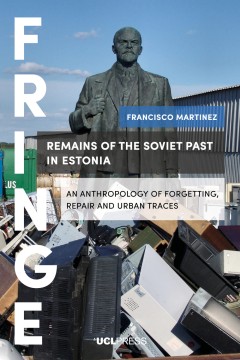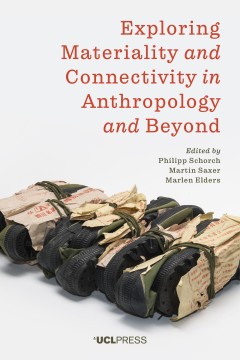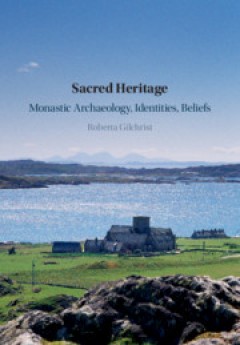Filter by

At home in Renaissance Bruges : connecting objects, people and domestic space…
How did citizens in Bruges create a home? What did an ordinary domestic interior look like in the sixteenth century? And more importantly: how does one study the domestic culture of bygone times by analysing documents such as probate inventories? These questions seem straightforward, yet few endeavours are more challenging than reconstructing a sixteenth-century domestic reality from written so…
- Edition
- -
- ISBN/ISSN
- 9789462703179
- Collation
- 320 p
- Series Title
- -
- Call Number
- 747.249332 DEG a

Remains of the Soviet past in Estonia : an anthropology of forgetting, repair…
What happens to legacies that do not find any continuation? In Estonia, a new generation that does not remember the socialist era and is open to global influences has grown up. As a result, the impact of the Soviet memory in people’s conventional values is losing its effective power, opening new opportunities for repair and revaluation of the past. Francisco Martinez brings together a numb…
- Edition
- -
- ISBN/ISSN
- 9781787353534
- Collation
- xix, 255 p. ill;
- Series Title
- -
- Call Number
- 974.98 REM F

MATERIAL CULTURE AND (FORCED) MIGRATION : materializing the transient
Material Culture and (Forced) Migration argues that materiality is a fundamental dimension of migration. During journeys of migration, people take things with them, or they lose, find and engage things along the way. Movements themselves are framed by objects such as borders, passports, tents, camp infrastructures, boats and mobile phones. This volume brings together chapters that are based on …
- Edition
- -
- ISBN/ISSN
- 9781800081604
- Collation
- xvii, 372 p. ill;
- Series Title
- -
- Call Number
- 304.8 MAT F

Exploring Materiality and connectivity in anthropology and beyond
Exploring Materiality and Connectivity in Anthropology and Beyond provides a new look at the old anthropological concern with materiality and connectivity. It understands materiality not as defined property of some-thing, nor does it take connectivity as merely a relation between discrete entities. Somewhat akin to Heisenberg’s uncertainty principle, it sees materiality and connectivity as tw…
- Edition
- -
- ISBN/ISSN
- 9781787357488
- Collation
- xvii, 259 p. ill;
- Series Title
- -
- Call Number
- 306 EXP P

London's urban landscape : another way of telling
London’s Urban Landscape is the first major study of a global city to adopt a materialist perspective and stress the significance of place and the built environment to the urban landscape. Edited by Christopher Tilley, the volume is inspired by phenomenological thinking and presents fine-grained ethnographies of the practices of everyday life in London. In doing so, it charts a unique perspec…
- Edition
- -
- ISBN/ISSN
- 9781787355583
- Collation
- xxi. ;ill. :458 p.
- Series Title
- -
- Call Number
- 307.760941. CHR l

Sacred heritage : monastic archaeology, identities, beliefs
Roberta Gilchrist critically evaluates the concept of sacred heritage. Drawing on global perspectives from heritage studies, archaeology, museology, anthropology and architectural history, she examines the multiple values of medieval Christian heritage. Gilchrist investigates monastic archaeology through the lens of the material study of religion and reveals the sensory experience of religion t…
- Edition
- -
- ISBN/ISSN
- 9781108678087
- Collation
- xvii, 276 p. ; ill
- Series Title
- -
- Call Number
- 274.103 GIL s

Early printed music and material culture in Central and Western Europe
This book presents a varied and nuanced analysis of the dynamics of the printing, publication, and trade of music in the sixteenth and early seventeenth centuries across Western and Northern Europe. Chapters consider dimensions of music printing in Britain, the Holy Roman Empire, the Netherlands, France, Spain and Italy, showing how this area of inquiry can engage a wide range of cultural, hist…
- Edition
- -
- ISBN/ISSN
- 9780429342844
- Collation
- XXI, 333 p.
- Series Title
- Music and Material Culture
- Call Number
- 070.5794094 EAR e

Things in culture, culture in things
This volume addresses the dynamics of materiality over time and space. In cross-cultural, multi-temporal and interdisciplinary studies the authors examine how things gain meaning and status, generate a multitude of emotions, and feed into the propagation of myths, narratives and discourses. The book is divided according to four themes: soft objects, stoic stories, consuming and the collectable,…
- Edition
- -
- ISBN/ISSN
- 9789949323944
- Collation
- -
- Series Title
- -
- Call Number
- 306.46 KAN t
Lineages and advancements in material culture studies. Perspectives from UCL …
This volume comprises a curated conversation between members of the Material Culture Section of University College London Anthropology. In laying out the state of play in the field, it challenges how the anthropology of material culture is being done and argues for new directions of enquiry and new methods of investigation. The contributors consider the ramifications of specific research method…
- Edition
- -
- ISBN/ISSN
- 9781003085867
- Collation
- XVIII, 282 p.
- Series Title
- -
- Call Number
- 306.0721 LIN l
How Things Make History: The Roman Empire and its terra sigillata Pottery
Bright red terra sigillata pots dating to the first three centuries CE can be found throughout the Western Roman provinces. The pots' widespread distribution and recognisability make them key evidence in the effort to reconstruct the Roman Empire's economy and society. Drawing on recent ideas in material culture, this book asks a radically new question: what was it about the pots themselves tha…
- Edition
- -
- ISBN/ISSN
- 9789048529933
- Collation
- x, 173p.: ill.
- Series Title
- -
- Call Number
- 938 OYE h
 Computer Science, Information & General Works
Computer Science, Information & General Works  Philosophy & Psychology
Philosophy & Psychology  Religion
Religion  Social Sciences
Social Sciences  Language
Language  Pure Science
Pure Science  Applied Sciences
Applied Sciences  Art & Recreation
Art & Recreation  Literature
Literature  History & Geography
History & Geography